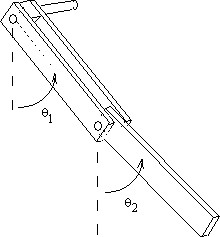Coupled, double, physical pendulum executes chaotic motion when non-linear initial conditions are imposed.
What it Shows
A double pendulum executes simple harmonic motion (two normal modes) when displacements from equilibrium are small. However, when large displacements are imposed, the non-linear system becomes dramatically chaotic in its motion and demonstrates that deterministic systems are not necessarily predictable.

How it Works
The double pendulum consists of two physical pendulums, each free to rotate a full 360° around its pivot. The pivots are 5/8" diam. ball-bearings. The two arms of the upper pendulum are fabricated from 1/4" thick aluminum and the lower pendulum from 1/2" thick aluminum. The pendulum lengths are approximately 10.75" and their masses are equal. The general design was adapted from an MIT version provided to us by Jack Wisdom.[1]
The Lagrangian of the system yields two coupled nonlinear second-order differential equations in the variables θ1 and θ2, too long to reproduce here. For small angles these equations become linear, with solutions that are linear combinations of the two normal modes of vibration. The two normal modes can easily be set into motion and demonstrated. The period of the symmetric mode in which the arms oscillate in the same direction is 1.2 sec. The antisymmetric mode (in which the upper and lower pendulums move in opposite directions) period is, of course, shorter and equal to 0.5 sec. Increasing the initial displacement to large angles results in chaotic motion which is quite fascinating and entertaining to watch. The pendulums rotate clockwise and counterclockwise in the most unexpected and surprising fashion, changing directions or suddenly increasing speed just when you think you know what they're going to do next.
The double pendulum can be set up with fairly reproducible initial conditions. For example, it can be fixed with a support arm so that it starts off with an initial angular displacement of 90°. But regardless how carefully one tries to secure identical releases from this initial configuration, the resultant motion is never the same. Any arbitrarily small change in the initial conditions results in a large change in the subsequent motion as these small deviations are amplified exponentially in time. This is one of the salient features of chaotic phenomena and it means that even "noise" in the initial conditions will be greatly amplified with time. Released as described above, our pendulum executes chaotic motion for about 1 minute and then settles down to nearly predictable motion for the next 8 or 9 minutes.
Setting it Up
The double pendulum support arm must be rigidly clamped to the edge of the lecture bench. Unnecessary vibrations in the mount will usurp its energy and it will not swing as long. It can be illuminated with a UV light for added effect (the fluorescent tape on it glows brilliantly in the darkened lecture hall).
NEVER EVER use your hand to try to stop the motion of the pendulum! The speed, inertia, and unpredictability of the apparatus poses a risk of serious injury to your hand if you try to reach in and stop it. If you need to stop the pendulum, use a scrap 2x4 to dampen the motion from a safe distance.
Comments
We cannot pass up this opportunity to contrast our world view with the Weltanschauung of two mathematicians who consider the complexity of their equations to be the ultimate beauty. In the introductory paragraph of their paper [2] they write, "As far as we know the experiment has never been performed but that is not important...in fact, it may not even be wise to do the actual experiment in order to understand the double pendulum...given that numerical computation is by now much faster than classical experimentation—why should anybody put an effort in the real thing?" Our mission is to inspire people's appreciation of the workings of the physical world with the real thing. And this thing is nifty.
[1] see, for example, T. Shinbrot, C. Grebogi, J. Wisdom, and J.A. Yorke, Am J Phys 60, 491 (1992).
"Chaos in a double pendulum" (a good introduction to and explanation of chaotic behavior)
J. Blackburn and G. Baker have investigated in detail and compared commercially available chaotic pendulums. They report their findings in Am J Phys 66(9), pp 821-830 (1998). This apparatus note will be useful to people who don't have the resources or desire to make their own. You will also find many good references for the theory in this note.
[2] Peter.H. Richter and Hans-Joachim Scholz, "Chaos in Classical Mechanics: The Double Pendulum," pp 86-97, Fachbereich Physik der Universität Bremen, D-2800 Bremen 33, Fed. Rep. of Germany.